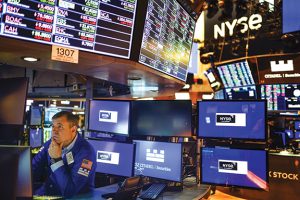Bloomberg
US equity futures fall along with stocks in Europe and the dollar resumed its upward march on Thursday after high US inflation hardened expectations for more aggressive Federal Reserve monetary tightening that could trigger a recession.
The Stoxx Europe 600 index declined more than 1%, dragged down by the telecom sector, where Ericsson AB plunged more than 10% after missing analysts’ quarterly profit estimates. Real-estate stocks slumped after Swedish property company Samhallsbyggnadsbolaget i Norden AB unexpectedly posted a loss, sending the shares down 15%.
S&P 500 and Nasdaq 100 contracts retreated more than 1% each ahead of the US second-quarter earnings season, kicked off on Thursday by JPMorgan Chase & Co. and Morgan Stanley. An Asian share index dropped for the third time in four days as China’s developer rout spread to the banking sector.
Traders have shifted towards expectations of an historic one percentage-point Fed interest-rate hike later this month after the US consumer-price gauge clocked a 9.1% annual climb. Fed Bank of Atlanta President Raphael Bostic said “everything is in play†to combat price pressures.
“It is clear that central banks around the world are laser-focused on fighting the entrenched inflation they helped to create, growth-be-damned,†said Jeffrey Halley, a senior market analyst at Oanda Asia Pacific Ltd. “US markets are pricing in faster Fed tightening, and a recession is on the way imminently.â€
The dollar pushed higher, hovering around the highest level in more than two years. Treasury yields climbed, led by two-year maturities that are more sensitive to imminent Fed moves. The inversion between two-year and 10-year yields — a potential recession indicator — is the deepest since 2000.
The euro falls back towards $1, after briefly dipping below it, and the European bonds plunged after Bloomberg reported that the European Commission had cut its growth forecast and lifted the inflation outlook for the common-currency area. Italy’s 10-year yield climbed more than 10 basis points and the country’s equty benchmark underperformed as Mario Draghi’s governing coalition appeared to be heading for a break-up.
The yen sank to a fresh 24-year low. Brent crude oil fell more than 2% to around $97 a barrel, near the lowest in four months. Bitcoin held below $20,000 as the bankruptcy filing of crypto lender Celsius Network weighed on sentiment.
The big question for markets is whether the latest US inflation print marks the peak. Commodity prices, pushed up this year in part by supply disruptions related to Russia’s war in Ukraine, have moderated somewhat of late. US producer-inflation and jobs data could give more clues on the outlook for prices and growth.
If higher costs prove to be persistent and come alongside a global economy buckling under rate hikes, that could be toxic for a range of assets already nursing heavy losses in 2022.
At this point, markets may be getting ahead of the Fed, according to Danielle DiMartino Booth, Quill Intelligence chief strategist. “We need to move the discussion onto how long is the recession going to be, how deep it’s going to be,†she said.
Fed Bank of Cleveland President Loretta Mester said in a Bloomberg Television interview the consumer-price report was uniformly bad and that the central bank will need to go well beyond the neutral level of rates. The figures don’t suggest a smaller hike than in June, she added.
Swaps referencing Fed meetings are priced for the policy rate to peak at about 3.7% this December, up from the current target range of 1.50%-1.75%. Traders then expect the Fed to start cutting rates to counter an economic slowdown.
 The Gulf Time Newspaper One of the finest business newspapers in the UAE brought to you by our professional writers and editors.
The Gulf Time Newspaper One of the finest business newspapers in the UAE brought to you by our professional writers and editors.
